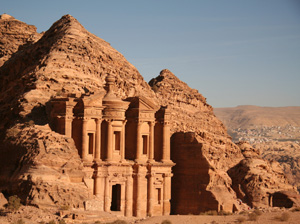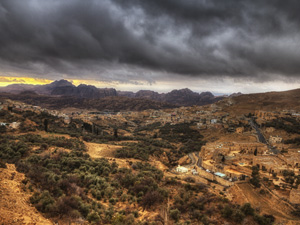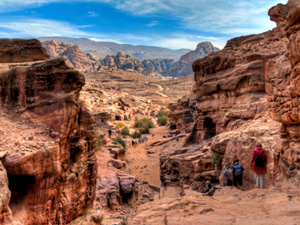|
Petra, the famous rock city, is located in the south of Jordan, and was created by the Nabataean Arabs. Since 1985 Petra belongs to the World Heritage Sites and since 2007 it is one of the New Seven Wonders of the World. The Nabateans settled here more than 2000 years ago and carved temples, tombs and houses in the red rose sandstone. When this nomadic Arabs showed up on the historical stage is not clear, the first definite historical mention of them is in 312 BC. They gained power through the control of the silk, spice and other trade routes that linked Asia and southern Arabia with Egypt, Syria, Greece and Rome. In the first century BC King Aretas III extended the Nabatean Empire to Damascus. Important for the Nabatean success was their ability to create a sophisticated water supply system with channels and cisterns.
Petra was chosen as the capital because it was located in a valley surrounded by sandstone mountains. There are many ways to get into Petra, but the access is not easy. But this didn’t prevent the Nabatean Empire to be annexed by the Romans in 106 and became part of Arabia Petraea. The city kept flourishing, but with the growing importance of Palmyra, in today's Syria, for the caravan trade Petra declined.
Around the 4th century Christians settled in Petra, still to see here are the remains of a Byzantine church. In 363 an earthquake destroyed many buildings. Knowledge of Petra was lost to the Western world until the Suisse Johann Ludwig Burckhardt rediscovered it in 1812.
Visitors enter Petra through the Siq, a narrow gorge, over 1 km in length, which is flanked by 80 metres high cliffs. Just walking through the Siq is an experience in itself. The colours and formations of the rocks are dazzling. As you reach the end of the Siq you will catch your first glimpse of Al Khazneh, known as the Treasury. Its name comes from the Bedouin belief that the Pharaoh hid his treasure in the urn at the top of the Kazneh. The monument consists of a massive façade, 30 meters wide and 43 meters high, carved out of the red rose sandstone in in the early 1st century.
From here walk along the Street of Facades, lined with tall monuments, after you see on the right side the so called Royal Tombs. Climbing up stairs the Urn Tomb, the Silk Tomb with rich coloured sandstone, the Corinthian and the Palace Tomb can be found. Another imposant monument in Petra is the Monastery "El Deir", 50 meters wide and 45 meters high. It is a great distance from he main entrance and can only be visited via a small path of more than 800 stairs. But all the efforts are worth it! For those who have more than one day to spend in Petra there are several other sites to discover, requiring hiking uphill. For instance the so called High Place of Sacrifice or Jabal Haroun where you find on top the white tomb of Aaron, brother of Prophet Moses.
|



|